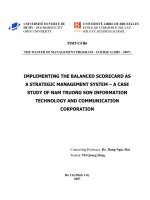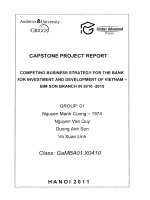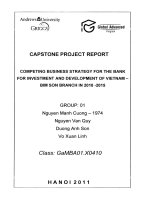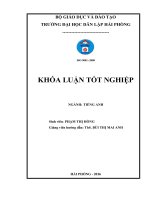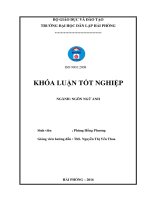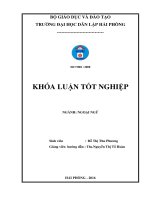Characteristics of depositional environments of middle Miocen of Thien Ung – Mang Cau structure of Nam Con Son basin (LV tốt nghiệp)
Bạn đang xem bản rút gọn của tài liệu. Xem và tải ngay bản đầy đủ của tài liệu tại đây (4.54 MB, 53 trang )
VIETNAM NATIONAL UNIVERSITY, HANOI
VNU UNIVERSITY OF SCIENCE
FACULTY OF GEOLOGY
Nguyen Thuy Linh
CHARACTERISTICS OF LITHOFACIES –
PALEOGEOGRAPHY AND SEQUENCE
STRATIGRAPHY OF MIDDLE MIOCENE
FORMATION IN THIEN UNG-MANG CAU
STRUCTURE OF NAM CON SON BASIN
Submitted in partial fulfillment of the requirements for the degree of
Bachelor of Science in Geology
(International Standard Program)
Hanoi - 2017
VIETNAM NATIONAL UNIVERSITY, HANOI
VNU UNIVERSITY OF SCIENCE
FACULTY OF GEOLOGY
Nguyen Thuy Linh
CHARACTERISTICS OF LITHOFACIES –
PALEOGEOGRAPHY AND SEQUENCE
STRATIGRAPHY OF MIDDLE MIOCENE
FORMATION IN THIEN UNG-MANG CAU
STRUCTURE OF NAM CON SON BASIN
Submitted in partial fulfillment of the requirements for the degree of
Bachelor of Science in Geology
(International Standard Program)
Supervisor(s): Prof.Dr. Tran Nghi
Hanoi - 2017
Acknowledgment
Thesis of bachelor is one of the most valuable experiences in student’s
life. I would not be able to finish my thesis of bachelor without the support of
Vietnam University of Science – Viet Nam National University and specially
my supervisor, Prf. Tran Nghi
Firstly, I would like to say thank you to Prof. Tran Nghi for his
supervision. He always gave me the best advice and enthusiastic guidance.
Without his valuable support. This project cannot have been possible.
Secondly, I would like to thank the VNU University of Science for
letting me fulfill my studying process here. I am excessively grateful for all
teachers in the Faculty of Geology who have taught me knowledge and
experience about geology for completing my thesis.
Despite of the best efforts, there would be remaining of mistakes and
omission in the thesis. I do hope to receive comments in order to have better one.
Finally, I am so thankful for all again.
Student
Nguyen Thuy Linh
Content
Nguyen Thuy Linh...................................................................................1
Nguyen Thuy Linh...................................................................................2
CHARACTERISTICS OF LITHOFACIES – PALEOGEOGRAPHY
AND SEQUENCE STRATIGRAPHY OF MIDDLE MIOCENE
FORMATION IN THIEN UNG-MANG CAU STRUCTURE OF
NAM CON SON BASIN ........................................................................2
List of abbreviation
Co
Fm
I
Li
Md
Me
Q
Ro
So
Sk
TST
HST
LST
TƯ - MC
Compaction coefficient
Formation
Secondary variation
coefficient
Cement
Medium grain size
Effective porosity
Quartz
Rounded coefficient
Sorted coefficient
Symmetry coefficient
Trasgressive system tract
Highstand system tract
Lowstand system tract
Thiên Ưng – Mãng Cầu
List of figure
List Table
Table.1.1: Classification diagram of sandstone according to F.J. Pettijohn
(1973).............................................................Error: Reference source not found
Table 1.2: Classification and nomenclature of arkose sandstones............Error:
Reference source not found
Table 1.3 Classification and nomenclature of graywake sandstones........Error:
Reference source not found
Table 1.4: The correct equation % grain size into the real grain size.......Error:
Reference source not found
(only clastic grains)........................................Error: Reference source not found
Table 1.5: The correct equation % grain size into the entire rocks...........Error:
Reference source not found
Table 1.6: Classification of sorted grades.....Error: Reference source not found
Table 1.7 : Classification of secondary variation degree.....Error: Reference
source not found
Table 3.1: Evaluation ability of reservoir rock. [13]....Error: Reference source
not found
Nguyen Thuy Linh
Bachelor Thesis
INTRODUCTION
The exploration has carried out more than a half of the century. Viet
Nam has identified eight petroleum sedimentary basins of Cenozoic age on
the continental shelf and marine zones of Viet Nam. There are 7 basins, it
includes: Red River sedimentary Basin, Hoang Sa sedimentary Basin, Phu
Khanh sedimentary Basin, Nam Con Son sedimentary Basin, Cuu Long
sedimentary Basin, Tu Chinh – Vung May sedimentary Basin and Malay –
Tho Chu sedimentary Basin in order from North to South. The Petroleum
Industry contributes about one-third to the national budget every year.
Nam Con Son basin in general and Central regions in particular Nam
Con Son basin is an important object of oil and gas search in Vietnam oil
basin system and it has been invested in research since the 70s of the 20th
century because historical circumstances as well as the complex of the
geological characteristics of the basin so the work of study to assess the
characteristics of lithology and depositional environments are not realized in a
uniform. This is an important prerequisite to assess oil and gas potential in the
area, so I have chosen thematic titled “characteristics of depositional
environments of middle Miocen of Thien Ung – Mang Cau structure of Nam
Con Son basin.”
Thesis focus on researching the environmental
characteristics of the Middle Miocene sediments and range research focuses
on Thien Ung - Mang Cau structure, the central area Nam Con Son basin.
The purpose of topic:
The topic purposed we know the lithological composition, the
environmental characteristics, sedimentary rock, lithofacies, and sedimentary
systems in the middle Miocene period. Since, it contribute for search and
exploration oil and gas on the basis of constitution and development of source
rock, reservoir rock and seal rock and evaluation of petroleum potential.
Term of thesis includes:
Chapter 1: Overview
Chapter 2: Sequences stratigraphy and relationship with lithofacies –
paleogeography
Chapter 3: Evaluation of petroleum potential
1
Nguyen Thuy Linh
Bachelor Thesis
CHARACTERISTICS OF LITHOFACIES –
PALEOGEOGRAPHY AND SEQUENCE
STRATIGRAPHY OF MIDDLE MIOCENE THIEN
UNG-MANG CAU STRUCTURE OF NAM CON SON
BASIN
Abstract: The paper introduces sequence stratigraphy and lithofacies
paleogeography of middle Miocene of the Thien Ung – Mang Cau structure in
the center area of Nam Con Son basin based on the analysing results of
lithologic thin section and structural characteristics of core samples. Basin of
middle Miocene has 3 systems tracts: (1) Lowstand systems tracts (LST); (2)
Transgressive systems tracts (TST); (3) Highstand systems tracts (HST). Each
systems has feature of lithofacies and representative paragenetic sequence. It
is conformed absolute and relative sea level. Lowstand systems tracts
included 3 main paragenetic sequences: (1) Alluvial sand, silt LST facies (ar);
(2) Delta silt, sand, clay LST facies (amr); and (3) Shallow marine clay, silt,
sand LST facies(mt/amr). Transgressive systems tracts included 5 main
paragenetic sequences: (1) Coral reef (TST) facies (mt Co); (2) Lagoon, bay
limes, clay (TST) facies (mt); (3) Shallow marine sand, silt, clay consist limes
(TST) facies (amr/amt); (4) Alluvial sand, silt (TST) facies (at) and (5)
Limes-dolomite (TST) facies. Highstand systems tracts concluded 3 main
facies: (1) Coral reef (HST) facies; (2) Shallow marine sand, silt, clay (HST)
facies (amt/amr); (3) Lagoon, bay limes (HST) facies (mr).
Keywords: Lithofacies – paleogeography, sedimentary systems tracts,
sequences stratigraphy, paragenetic sequence, lowstand systems tracts,
highstand systems tracts.
2
Nguyen Thuy Linh
Bachelor Thesis
CHAPTER 1: OVERVIEW
1. GEOGRAPHYCAL LOCATION
Nam Con Son occupies about 100.000km 2 kilometers and located from
6o 00' to 90 45' north latitude and 1060 00' east longitude. The northern
boundary of the basin is the Con Son zone of uplift, in the west and the south
it is KHorat - Natuna zone of uplift, while the east is the Tu Chinh - Vung
May basin and the Phu Khanh basin in the east.[5] Sedimentary parameters
analysed from the lithologic thin section of about middle Miocene age of
drilling wells T-1, T-2, T-3 and T-6. (Fig 1.1)
Fig 1.1: Geography location of TƯ - MC in Nam Con Son Basin [5]
2. STUDIED HISTORY REVIEW
Oil and gas exploration activities in Nam Con Son Basin began in the
1970s of the last century. There were 26 foreign contractors surveyed nearly
60,000km 2D seismograph and 5,400km2 3D seismographs, drilled 78 wells,
quality test and exploration wells, determined 5 mines and 17 oil discovery.
Now, 7 foreign contractors are active. Research on the geological and
hydrocarbon resources of Nam Con Son basin has many study project,
3
Nguyen Thuy Linh
Bachelor Thesis
especially the topics of state have contributed and effectively in the
exploration and mining. However, Nam Con Son basin has complex geology
conditions, it is necessary to continue researching with new methods and
technologies to establish the scientific basis for planning the exploration and
exploitation in this sedimentary basin. Based on the characteristics and results
of each period, the history of studies on the Nam Con Son Basin can be
divided into 4 periods: Before 1975, 1976 – 1980, 1981 – 1989 and 1990present. [5]
2.1. Before 1975
USA and British company such as Mandrell, Mobil Kaiyo, Pectin,
Esso, Union Texas, Sun Marathon and Sunning Dale surveyed region and
explored oil in Nam Con Son basin very early 1975. On the basis of the
research results obtained at the end of 1974 and in early 1975, Pecten and
Mobil drilled five wells in different parcel and structures (Mía - 1X, DH - 1X,
Hồng - 1X , Dừa - 1X, and Dừa - 2X), in which Dừa - 1X wells have detected
oil. At the end of this period, there were 3 reports. It presented about
evaluating research results for the parcel, and which the most important and
remarkable was the Mandrell Report. Inside, this paper presents two maps,
anomaly magnetic maps and gravity maps of 1 / 500,000 for the whole
continental shelf of Vietnam. However, at this stage, it had not yet a general
report about the structural characteristics and geological development history
of the whole region and each other plots.
2.2. 1976 – 1980
The AGIP and BOW VALLEY companies surveyed (14,859 km 2D
seismic networks up to 2x2 km) and drilled 8 wells (04A -1X, 04B - 1X, 12A
- 1X, 12B - 1X, 12C - 1X, 28A - 1X, 29A - 1X). Based on the geological,
geophysical and drilling surveys, the above companies have established
isochronous diagrams according to the reflecting layers at different ratios and
have summarized reports. “Seismic demonstrated and evaluated of petroleum
potential of Vietnam continental shelf" by Daniel S. and Netleton. AGIP has
4
Nguyen Thuy Linh
Bachelor Thesis
made a point of view of geological structure and evaluated of oil and gas
potential in plots 04 and 12.
2.3. 1982 – 1987
The birth of Vietsovpetro (VSP) has opened a new stage of Vietnam's
oil and gas industry. However, some reasons, geological and geophysical
have been invested in Cuu Long basin, while Nam Con Son basin has only
limited area, especially, structure of Dai Hung (VSP drilled 3 wells). Some
report are important such as “tectonic of Cenozoic basin in continental shelf
in Vietnam” by Le Trong Can et al (1985) and “Geological synthesis geophysics, calculating hydrocarbon and direction of oil and gas exploration
in the next stage in the South Vietnam continental shelf by Ho Dac Hoai, Tran
Le Dong, 1986 and “Geological structure and evaluation petroleum potential
of Tertiary Basins in East Vietnam" in 1987.
2.4. 1988 – present
When the State promulgated the Foreign Investment law, 20
contractors have signed contracts for exploration and exploitation in the Nam
Con Son basin. The contractors surveyed 54,779 km 2D seismic and 5,399
km2 3D seismic, drilled 62 wells explored and exploited. Dai Hung mine
exploited in 1994, Lan Tay gas field in 2002 and the gas fields Rong Doi Rong Doi Tay and Hai Thach were will prepare to exploitation. The
contractors have also reported plots and well reports, but these are basically
quick reports for production. General Department of Vietnam Oil and Gas
(now the Vietnam Oil and Gas Corporation), there are some reports which
research general of basin. That is the report: “Precise geological structure,
evaluation petroleum potential and proposal of orientations for exploration of
oil and gas in Nam Con Son basin” by Nguyen Giao, Nguyen Trong Tin and
others in 1990, “Evaluation petroleum potential in Nam Con Son basin "by
Nguyen Trong Tin et al. 1993 and “Geological structure and oil reserves in
the Eastern part of the Nam Con Son basin" by Nguyen Trong Tin et al. 1995;
reports: "Study on evaluation petroleum potential in the western part of Nam
Con lake Son "by Nguyen Trong Tin et al. 1996. Based on the result of
5
Nguyen Thuy Linh
Bachelor Thesis
research of oil and gas exploration and exploitation of sedimentary basins
throughout the continental shelf of Vietnam, many researches have evaluated
the overall mechanism of basin formation, structural characteristics of basin,
geological development history and evaluation oil and gas potential on the
entire continental shelf of Vietnam. Some important research such as:
Synthesis of geological and geophysical, calculation of carbon-hydrogen and
predicted reserves, draft method of search and exploration of Vietnamese
continental shelf of Ho Dac Hoai, Tran Le Dong, 1986. "Stratigraphy and
development process of Tertiary sediment of Vietnam continental shelf" by
Do Bat, 2000. "The evaluation of oil and gas exploration in Vietnam in the
1988-2000 and the direction exploration and exploitation in the future" by the
Petroleum Institute. "Cenozoic tectonic evolution: formation of hydrocarbon
reservoirs in Vietnam" by Ngo Thuong San, Cu Minh Hoang and Le Ly Thi
Hue, 2005...[5]
3. NATURAL CONDITION
3.1 Stratigraphy
The sedimentary stratigraphy of the Nam Con Son basin as well as the
study area includes:
Cau Formation (E23 c)
The beds of continental facies in the N – NW and W – SW of the Nam
Con Son Basin, but of deltaic, lacustrine – lagoonal facies in the East of the
basin, were described as Cau Fm (Le Van Cu, 1982), it occurs rather
restrictedly in the basin due to its absence in uplift zones.[7]
The characteristic section of the formation has been established in the
borehole Dua – IX with a thickness of 358m (at the depth of 3680 – 4038m),
including mainly grey quartz and stone interbedded with brown claystone and
siltstone.
Generally in the basin, the formation is composed of 3 main parts: 1/
Fine to coarse – grained sandstone, in some places, thick – bedded gritstone,
pebble – bearing sandstone with some interbeds of grey siltstone or claystone
and thin coal seams; in some boreholes, there still are effusive beds (andesite,
6
Nguyen Thuy Linh
Bachelor Thesis
baset or diabase); 2/ Dark – grey, thick – bedded claystone with some
interbeds of grey siltstone and sandstone, rich in lime and organic matters,
together with coaly shale and coal seams; 3/ Small to medium – grained
sandstone, in some places containing forams, with some interbeds of ash –
grey siltstone and claystone.
The thickness and above subdivision of the Fm vary in different areas
of the basin. The upper part does not exist in some places, or in the Thanh
Long structure the coal – bearing level strongly increases. The thickness of
the Fm varies from 100 to 700m in western lots but reaches up to thousand
metres in eastern ones.
The characteristic spores and pollens consist of Florschuetzia trilobata
met
together
with
Magnastriatites
Howard,
Osmunda,
Cyclophorus,Pinuspollenites, Varrncatosporites, etc.. Fresh – water algae
comprise Pediastrum, Bosedinia. The Cau Rm rests unconformably upon
bedrocks and under the Dua Fm. Its Oligocene age has been determined on
the palynological basis with the presence of Florschuetzia trilobata and the
absence of other species of this genus. Sandstone of this Fm has been
considered as having medium petroleum – bearing ability.[5]
Dua Formation (N11 d)
Deltaic sediment interbedded with littoral ones overlying the above Cau
unit were described as the Dua Fm (Ngo Thuong San, 1981), it is largely
distributed in the Nam Con Son Bansin.
The characteristic section of the Fm has been established in the
borehole Dua – IX with a thickness of 828m (at the depth of 2852 – 3680m),
including black – grey claystone, grey siltstone interbedded with small –
grained sandstone and lenses of brown coal. The middle part of this section
contains much sandstone, in some places, bearing glauconite and pyrite.
Generally in the basin, the Dua Fm is composed mainly of light – grey
sandstone, siltstone interbedded with grey claystone, marly clay, clay rich in
organic matters and thin coal seams, sometimes thin beds of limestone. The
sediments in the basin have the finer tendency upwards and the marine
7
Nguyen Thuy Linh
Bachelor Thesis
character of the basin. Some claystone members are possibly local confining
beds. The thickness of the Fm varies from 100 to 1000m.
The collected spores and pollens are abundant, belonging to the
Florchuetia levipoli zone and the Magnatriatites howardi acme zone of Early
Miocene age. The N7 – N8, foraminifera zones have been determined by
Praeorbulina (Pr.transitoria, Pr. glomerosa) together with the absence of
Orbulina universa. Nannoplanktons of the Miocene NN4 zone include
Helicosphaera anipliaperta, Discoaster druggili. Together with forams, it
occurs only in the east of the basin.
The Dua Fm rests unconformably upon the Cau Fm and conformably
under the Thong – Mang Fms. It has been dated as Early Miocen according to
paleontological materials.
Thong – Mang Cau Formation (N12 t-mc)
In the Cuu Long Basin, the Thong – Mang cau Fm (Do Bat, 2000) is
composed of delt plain sediments in the west of the basin passing to littoral
ones in the east, overlying the Dua Fm. It is distributed largely in the basin.
The characteristic section of the Fm was established in the borehole
GK. Dua – IX with a thickness of 682m (at the depth of 2170 – 2852m),
including main glauconite – bearing calcareous sandtone with thin interbeds
of claystone, marl grading upwards into an intercalation of calcareous
terrigenous beds and grey limestone. The terrigenous – carbonate beds are
strongly developed towards the northeastern margin of the basin, consisting
mainly of grey, usually glauconite – bearing sandstone, siltstone and
claystone, marl interbedded with lenses or thin beds of limestone containing
especially many forams. Carbonate beds are distributed rather largely in
uplifted areas in the center of the basin, and in the east, they were formed in
the open sea condition of the continental shelf and contain many corals. They
have the mean porosity of 10 – 20% and can be good petroleum reservoirs.
The collected fossils consist of spores and pollens of the Middle
Miocene Florschutzia meridionalis Zone, including FI. Meridionalis,
FI.Trilobata, FI.Levipoli and Magnastriatite howardi. In the east of the basin,
limestone is abundant in forams of the N9 – N13 Zones of Middle Miocene,
8
Nguyen Thuy Linh
Bachelor Thesis
determined by Orbulina universa and Globorotalia mayeri, Gl.fohsi.
nannoplanktons are also widespread in the east, with the Middle Miocene age
has been established on the paleontological basis.
Nam Con Son Formation (N13 ncs)
The Nam Con Son Fm (Le Van Cu, 1982) was formed in the littoral
environment belonging to the inner zone of marine terrace in the western part
of the basin and to the middle or outer zone in the eastern part. It occurs rather
largely in the Nam Con Son Basin.
The characteristic section of the formation was established in the
borehole GK. Dua – 1X with a thickness of about 300m (at the depth of 1868
– 2170m), including mainly white –grey; fine sandstone interbedded with
calcareous siltstone, claystone; and limestone containing many foraminifer
fossils. In the basin confines, the Nam Con Son Fm has clear facial change. In
the northern margin and the W – SW part, it is composed mainly of
terrigenous beds, such as greenish – grey claystone, marl interbedded with
calcareous sandy siltstone, sometimes with some lenses or thin beds of
limestone. In some uplifted areas situated in the E – SE, it comprises mainly
carbonate beds. The thickness of the Fm varies from 200 to 600m.
The collected spores and pollens characterize the Late Miocene FI.
meridionalis Zone. As for forams, the N16 – N18 zones have been
determined on the basis of Globigerinoides ruber, Gds.obliquus,
Globorotalia ditertrei, Gl.acostaensis (FAD since N16), Sphaeroidinella
dehiscens (FAD since N19).
The Nam Con Son Fm rests unconformably upon the Thong – Mang
Cau and under the Bien Dong Fms. Its Late Miocene age has been determined
on the paleontological basis. [7]
Bien Dong Formation (N2 – Q bđ)
In the Nam Con Son Basin, the characteristic section of the Fm is about
1300m thick (in the depth of 600 – 1900 m), including mainly grey, yellowish
sand, silt and clay containing forams, millusks, bryozoan, etc.. in uplifted
9
Nguyen Thuy Linh
Bachelor Thesis
areas situated in the east of the basin, reef carbonate rocks are rather
continuously developed.
In the above basins, the Bien Dong Fm contains forams with many
betonic forms and some planktonic ones, among them the species having
LAD in N19 are Globigerinoides obliquus, Gdes,extremus, Globoquadrina
altispira, Globorotalia miocenica accompanied by Sphaeroidinella
subdehiscens having FAD in N19 of Pliocene. Nannoplanktons are also
abundant; the NN12 – NN18 Zones have been determined by the LAD of
Discoaster and Sphenolithns abies, while older species are absent, especially
Disc.quinqueramus of the NN11 Zone. Collected sporomorphs belong to the
Dacrydium Assemblage, characterized by Dacrydium and the absence of
Magnastriatites Howardi and almost all old species of Florchuetzia. [7]
3.2 Structures – Tectonics
a. Faulting
There are 4 main fault systems in the Nam Con Son Basin. It includes:
Para - meridian Fault System, Northeast – Southwest Fault System,
Northwest – Southeast Fault System. (Fig.1.2)
10
Nguyen Thuy Linh
Bachelor Thesis
Fig 1.2: Fault systems in the Nam Con Son Basin
Para - Meridian Fault System
Comprised of all the faults developed in the same direction was formed
and developed in the Nam Con Son basin. This is a fault which is important in
the formation and development of this basin and they are major in divide the
structure of basin into different structural zones. In this fault system, it has
important fault such as Hau River fault, the Dong Nai fault in the West and
the Hong – Tay, Mang Cau fault in the central, they are faults that formed
before the rift and continuous active during the rift period of basin. [9]
Northeast – Southwest Fault System
In Nam Con Son Basin, Northeast – Southwest Fault System are
developed and concentrated in the eastern part of the basin, they are formed
11
Nguyen Thuy Linh
Bachelor Thesis
by the tensile mechanism because the main effect of the stretching process of
the East Sea. These faults were formed and developed mainly during the
Early Eocene - Oligocene Rift and continued to develop during Late Miocene
– Early Miocene. Thus, the faults of NE - SW systems developed at two
different times and coincide with the two stretches. The first phase is in
Eocene - Oligocene and the second phase in the East Sea. They have major
role in the formation and development of the eastern part of the basin.
Para - Latitude Fault System
It developed mainly in the transition zone and NE of the basin. These
are faults have higher intensity than NE – SW system, but smaller than the
meridian fault system, these faults develop from the foundation and penetrate
to the Middle Miocene and stop in the end of Middle Miocene. Para - Latitude
Fault System has an important role in the division of sub – zones, such as the
boundary between the Northern and the Natuna.[9]
Northwest – Southeast Fault System
In the Nam Con Son sedimentary basin, the faults in the NW - NW
direction are individual faults, which are developed in the transition zone and
in the eastern valleys. This fault has low intensity and amplitude, it is not
necessary in formation and development in sedimentary basins but make
complex structural in basin.
3.3. Tectonic zonation.
Based on the parameters of sediment thickness, material compositions,
the distribution of sedimentary formations, tectonic characteristics and
formation mechanism, the Nam Con Son basin can be divided into following
tectonic units. (Fig.1.3)
12
Nguyen Thuy Linh
Bachelor Thesis
Fig 1.3: Tectonic zonation map of Nam Con Son Basin
The Western Differentiated zone
This zone covers Blocks 19, 21, 22, 27, 28 and 29, it is mostly
characterized by the presence of narrow deep troughs, major faults
accompanying with the sub – meridian trending anticlines. This zone is
subdivided into smaller structural sub – zones by the Hau river fault:
+ The Western marginal sub – zone;
+ The Western differentiated sub – zone.
13
Nguyen Thuy Linh
Bachelor Thesis
The Central Trough zone
The central trough zone includes almost of the Eastern area of Nam
Con Son Basin. It extends in the NE – SW and expands to the Miocene due to
the ocean spreading process. This zone is also subdivided into 2 smaller units:
+ The Southeast margin of Con Son swell;
+ The central trough.
The central trough comprises the Northern trough sub-zone, the central
trough sub – zone, and Dai Hung – Mang Cau uplift belt.[5]
The Hong – Natuna Swell (uplift zone)
This zone is an uplift one, relatively stable throughout history of
geological Cenozoic development. It characterized by structure like block.
The thickness of Cenozoic sediments is only about 1,600 – 2,800m. On the
uplift zone, fault systems develop with the NE – SW and N – S.
In short the existence of the above mentioned various structural
elements reflect the diversity of the basement relief and cover structure as
well as the multiphase tectonic activities of the basin. [4]
4. RESEARCH OF METHOD
4.1. Method optical microscopy analysis
The purpose of this method is to get possible optical data of minerals
produced by the interaction of visible light with the transparent samples
basing on the principle of refractive light. The result of the analysis is
determined the composition of rock forming minerals, composition and type
of cement, texture of rock, classification and nomenclature of rock.
Optical studies allow direct observation of mineral characteristics and
rock textures on microscopic scale. The features are used in the sorting,
rounding of the clasts, the secondary variation (subsequent variation) and
determined sedimentary environment. [2]
14
Nguyen Thuy Linh
Bachelor Thesis
Fig 1.4: Set of sieve
Fig1.5: Microcopy
a. Classification sedimentary rock
In sedimentary rock, there are some common mineral such as
- Quartz (Q): occurs magma, sedimentary, metamorphic
- Feldspar (F): plagioclase, feldspar kali
- Rock fragment: metamorphic fragment, sediment, acid and
intermediate extrusive.
Besides, there are some accessory mineral such as: biotite, muscovite,
tourmaline, zircon, monazite, granate…
Today in Vietnam, scientists are using classification method of F.J.
Pettijohn (1973) mainly. In which, primary three factors also are the basis of
classification that is quartz content (Q), cement content (Li), and ratio of
feldspar to rock fragment (R). Each triangle is divided into 5 fields with 3
tops are Q, F, R (Fig.1.4) and the name of rocks as Fig (1.5, 1.6)
15
Nguyen Thuy Linh
Bachelor Thesis
Q
1
90
2
75
Q
3
75
4
R
F
2
75
5
4
1
90
90
90
3
75
5
R
F
a . (L i < 1 5 % )
b . (L i > 1 5 % )
Table.1.1: Classification diagram of sandstone according to F.J. Pettijohn (1973)
When Li <15%
Field
Q (%)
F/R
Rock name
1
≥ 90
2
75 – 90
<1
Quartz – arkose sandstone
3
75 – 90
>1
Quartz – lithic sandstone
4
≤ 75
<1
Ackotic sandstone
5
≤ 75
>1
Ackose - lithic sandstone
Quartz sandstone
Table 1.2: Classification and nomenclature of arkose sandstones
When Li > 15%
Field
Q (%)
F/R
Rock name
1
≥ 90
2
75 – 90
<1
Quartz – grauwacke sandstone
3
75 – 90
>1
Quartz – lithic sandstone
4
≤ 75
<1
Grauwacke sandstone
5
≤ 75
>1
Grauwacke - lithic sandstone
Quartz sandstone
Table 1.3 Classification and nomenclature of graywake sandstones.
b. Grain size analysis by thin section
Grain size analysis is methods that determine physical parameters of
the particles of clastic sedimentary rocks include medium grain size (Md).
16
Nguyen Thuy Linh
Bachelor Thesis
Sorted coefficient (So) and symmetry coefficient (Sk). However, the thin
section is random slice, so the size that measure by thin section do not similar
to the real size of the grains. Therefore, the requirement for granulometry by
thin sections that after measurement of the grains size, we must correct to get
the real size of the grain.[2]
M1, M2, M3, M4, M5 are contents of particle grades that measured and
T1, T2…. T5 are contents of ranks particle after corrected, the equation to
correct the real size of the grain.
Finally, the real grades are corrected into the real grades of entire rocks
(both clasts and cement) (Fig 1.7) (Fig. 1,8)
C1, C2…C6 are particles rank contents of rock C1 + C2 +….C5=100% - C6
Grain size (mm)
Correct equation
2–1
T1 = 1.33 x M1
1 – 0.5
T2 = 1.36(M2 – 0.19T1)
0.5 – 0.25
T3 = 1.44[M3 –(0.012T1 +0.044T2+0.165T3)
0.25 – 0.1
T4 = 1.79[M4 –(0.012T1 +0.044T2+0.165T3)
0.1 – 0.01
T5 = M5 –(0.001T1 +0.037T2+0.142T3+0.44T4)
Table 1.4: the correct equation % grain size into the real grain size
(only clastic grains)
Grain size (mm)
Correct equation
2–1
C1 = T1(100 – C6)/100
1 – 0.5
C2 = T2(100 – C6)/100
0.5 – 0.25
C3 = T3(100 – C6)/100
0.25 – 0.1
C4 = T4(100 – C6)/100
0.1 – 0.01
C5 = T5(100 – C6)/100
< 0.01
C6 = content of cement
Table 1.5: the correct equation % grain size into the entire rocks
After that, we draw the accumulative curve of grain size and
distribution curve of grain size as the (Fig 1.9, 1.10)
17
Nguyen Thuy Linh
Bachelor Thesis
Fig 1.7 The accumulative
curve of grain size
Fig 1.8 The distribution curve of
grain size
Then, we can be calculated parameters:
• Medium grain size Md= d50
• Sorted coefficient:
• Symmetry coefficient
c. Roundness coefficient
Roundness refers to the degree to which sharp corners and edges of
rocks or minerals have been worn away. It is a measure of the intensity and
degree of transportation and abrasion. It changes from 0 to 1. (Fig 1.11)
Roundness grades
Grade 1
Grade 2
Ro
0 – 0.1
0.1 – 0.3
18
Roundness level
Not rounded
Poor
Nguyen Thuy Linh
Grade 3
Grade 4
Grade 5
Grade 6
Bachelor Thesis
0.3 – 0.5
Medium
0.5 – 0.7
Fairly good
0.7 – 0.9
good
0.9 -1.0
Very good
Table 1.6: classification of sorted grades
• Maturity
Maturity calculated by:
Where:
Ro – roundness coefficient;
Q – quartz content;
So – Sort coefficient;
Li – Content of cimented base
• Secondary variation coefficient (I)
Secondary variation coefficient is the alterable sign of rock after
diagenesis to divide the changing levels from low to high. This method is
based on the type and amout of contact between clastic grains.
Where:
- Ai: amount of primary contacts of grains from measured line
number i;
- Bi: amount of secondary contacts of grains from line number I;
- n: amount of measured lines in thin section.
I varies from 0 to 1 and it can be classified as in Fig 1.12
Secondary variation coefficient (I)
0 – 0.25
0.25 – 0.5
0.5 – 0.75
Secondary variation degree
Early diagenesis
Late diagenesis
Katagenesis
19
